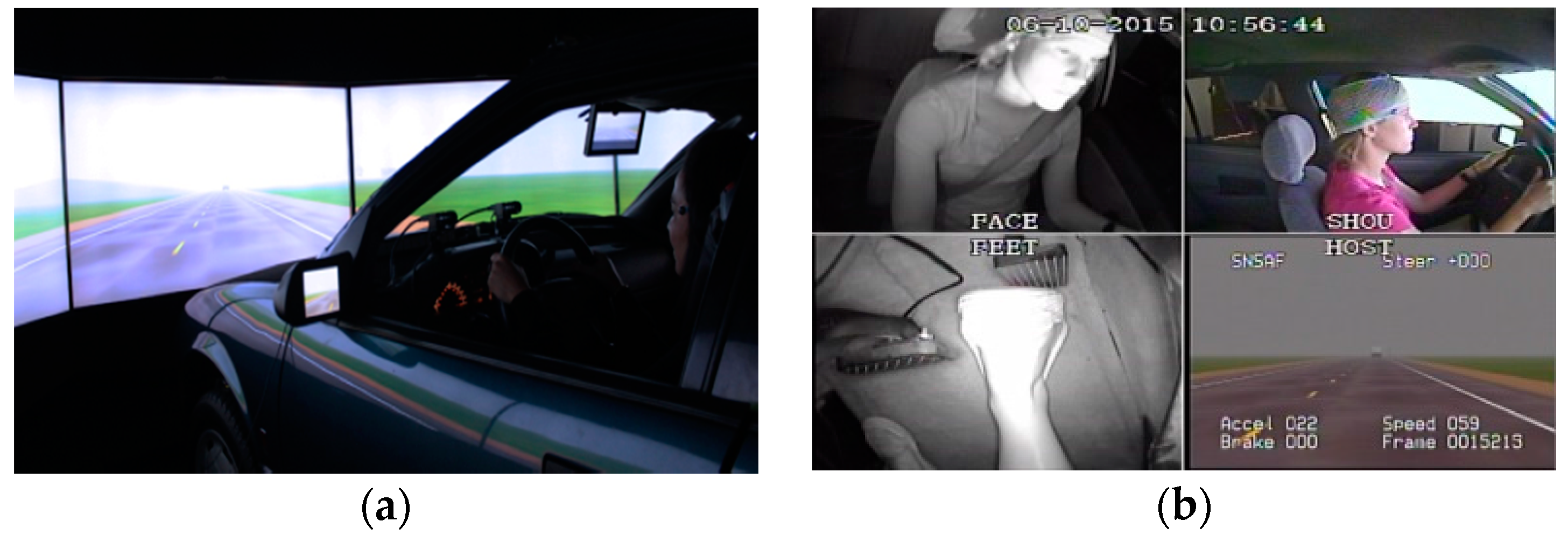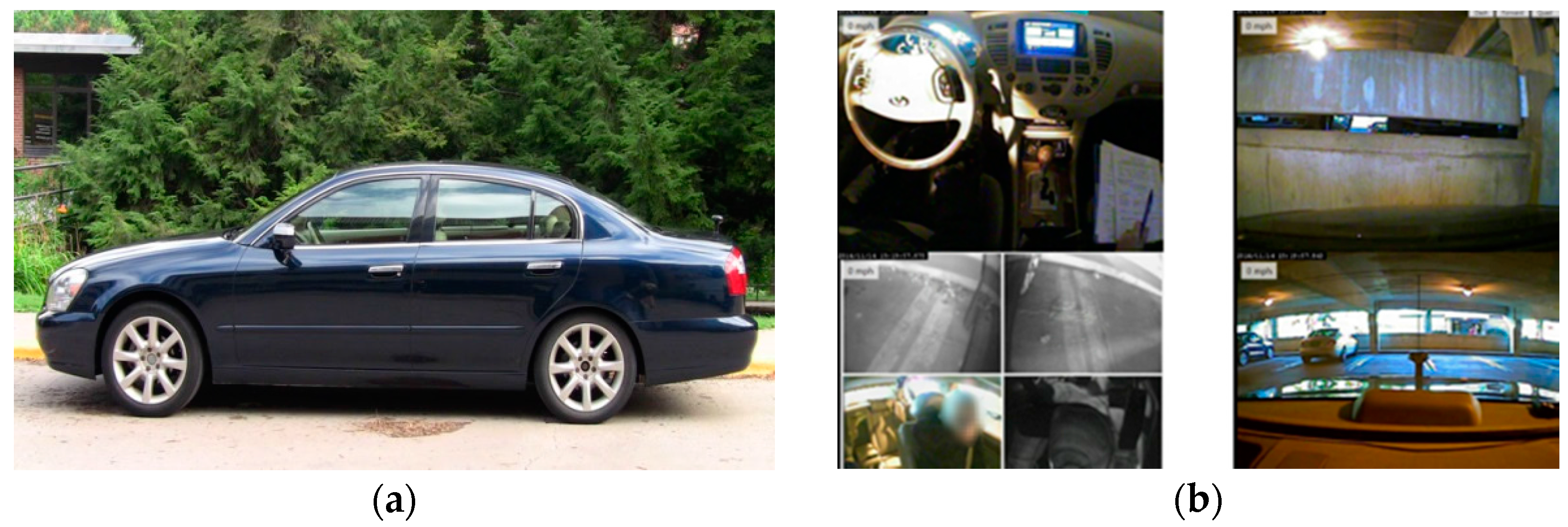Correspondence between Simulator and On-Road Drive Performance: Implications for Assessment of Driving Safety
Abstract
:1. Introduction
2. Methods
2.1. Sample
2.2. Procedure and Design
2.3. Measures
3. Results and Discussion
3.1. Age-Group Differences across the Two Platforms
3.2. Similarity in Relative Rank-Order across the Two Platforms
4. Conclusions
Acknowledgments
Author Contributions
Conflicts of Interest
References
- Anstey, K.J.; Wood, J.; Lord, S.; Walker, J.G. Cognitive, sensory and physical factors enabling driver safety in older adults. Clin. Psychol. Rev. 2005, 25, 45–65. [Google Scholar] [CrossRef] [PubMed]
- Aksan, N.; Anderson, S.W.; Dawson, J.; Uc, E.; Rizzo, M. Cognitive functioning differentially predicts different dimensions of older drivers’ on-road safety. Accid. Anal. Prev. 2015, 75, 236–244. [Google Scholar] [CrossRef] [PubMed]
- Rizzo, M. Impaired driving from medical conditions: A 70-year-old man trying to decide if he should continue driving. J. Am. Med. Assoc. 2011, 305, 1018–1026. [Google Scholar] [CrossRef] [PubMed]
- Mullen, N.; Charlton, J.; Devlin, A.; Bedard, M. Simulator Validity: Behaviors observed on the simulator and on the road. In Handbook of Driving Simulation for Engineering, Medicine, and Psychology; Fisher, D., Rizzo, M., Caird, J., Lee, J.D., Eds.; CRC Press: Boca Raton, FL, USA, 2011; pp. 13-1–13-18. [Google Scholar]
- Reiner, A. Assessment of simulator fidelity and validity in simulator and on-the-road studies. Int. J. Adv. Syst. Meas. 2010, 3, 110–124. [Google Scholar]
- Lee, J.D.; Ward, N.; Boer, E.; Brown, T.; Balk, S.A.; Ahmad, O. Exploratory Advanced Research: Making Driving Simulators More Useful for Behavioral Research—Simulator Characteristics Comparison and Model based Transformation; Final Report for Department of Transportation Federal Highway Administration; DTFH61-09-C-0003; National Technical Information Service: Springfield, VA, USA, 2013. [Google Scholar]
- Bedard, M.; Parkkari, M.; Weaver, B.; Riendaeau, J.; Dahlquist, M. Assessment of driving performance using a simulator protocol: Validity and reproducibility. Am. J. Occup. Ther. 2010, 64, 336–340. [Google Scholar] [CrossRef] [PubMed]
- Chrysler, S.; Cooper, J.; McGehee, D.V.; Yager, C. Comparison of driver distraction evaluations across two simulator platforms and an instrumented vehicle. In Proceedings of the Seventh International Driving Symposium on Human Factors in Driver Assessment, Training, and Vehicle Design, New York, NY, USA, 17–20 June 2013; pp. 544–550.
- Winter, J.C.F.; van Leeuwen, P.M.; Happee, R. Advantages and disadvantages of driving simulators: A discussion. In Proceedings of the Measuring Behavior, Utrecht, The Netherlands, 28–31 August 2012; pp. 47–50.
- Bella, F. Driving simulator for speed research on two-lane rural roads. Accid. Anal. Prev. 2008, 40, 1078–1087. [Google Scholar] [CrossRef] [PubMed]
- Tornros, J. Driving behavior in a real and a simulated road tunnel–A validation study. Accid. Anal. Prev. 1998, 30, 497–503. [Google Scholar] [CrossRef]
- Wade, M.G.; Hammond, C. Simulator Validation: Evaluating Driver Performance in Simulation and the Real World (Report No. 28); Minnesota Department of Transportation: Minneapolis, MN, USA, 1998. [Google Scholar]
- Lee, H.C.; Cameron, D.; Lee, A.H. Assessing the driving performance of older adult drivers: On-road versus simulated driving. Accid. Anal. Prev. 2003, 35, 797–803. [Google Scholar] [CrossRef]
- Lee, H.C.; Lee, A.H. Validity of driving simulator in assessing drivers with Parkinson’s disease. Adv. Transp. Stud. 2007, Special Issue, 81–90. [Google Scholar]
- Lee, H.C.; Lee, A.H.; Cameron, D.; Li-Tsang, C. Using a driving simulator to identify older drivers at inflated risk of motor vehicle crashes. J. Saf. Res. Sr. Transp. Saf. Mobil. 2003, 34, 453–459. [Google Scholar] [CrossRef]
- Yan, X.; Abdel-Aty, M.; Radwan, E.; Wang, X.; Chilakapati, P. Validating a driving simulator using surrogate safety measures. Accid. Anal. Prev. 2008, 40, 272–288. [Google Scholar] [CrossRef] [PubMed]
- Nasreddine, Z.S.; Phillips, N.A.; Bédirian, V.; Charbonneau, S.; Whitehead, V.; Collin, I.; Cummings, J.L.; Chertkow, H. The Montreal Cognitive Assessment (MoCA): A Brief Screening Tool For Mild Cognitive Impairment. J. Am. Geriatr. Soc. 2005, 53, 695–699. [Google Scholar] [CrossRef] [PubMed]
- Dawson, J.D.; Uc, E.Y.; Anderson, S.W.; Johnson, A.M.; Rizzo, M. Neuropsychological predictors of driving errors in older adults. J. Am. Geriatr. Soc. 2009, 58, 1090–1096. [Google Scholar] [CrossRef] [PubMed]
- Dawson, J.D.; Anderson, S.W.; Uc, E.Y.; Dastrup, E.; Rizzo, M. Ascertainment of on-road safety errors based on video review. In Proceedings of the Fifth International Driving Symposium on Human Factors in Driver Assessment, Training, and Vehicle Design, Big Sky, MT, USA; 2009; pp. 419–426. [Google Scholar]
- Classen, S.; Monahan, M.; Auten, B.; Yarney, A. Evidence-based review of interventions for medically at-risk older drivers. Am. J. Occup. Ther. 2014, 68, e107–e114. [Google Scholar] [CrossRef] [PubMed]


| Driving Tasks | Simulator-Based Measures | On-Road Drive | |
|---|---|---|---|
| Evaluation of Video for Safety in each Scenario | Vehicle Data | ||
| Lane change (lane change on straightaways, merging on/off ramp) | Number of rejected gaps, failure to use side-view and rear-view mirrors, number of hesitations (steering wheel reversals) | Gap size, time to complete lane change, type of gap (2-sided vs. other) | Failure to signal correctly, improper speed control during various stages of the task (on/off ramp; interstate/highway); blind spot monitoring |
| Lane keeping (straight and curved) | N/A | Standard deviation of lane position, total time off-center by more than 0.51 meters, time to correct off-center drifts | Touching/straddling, lane line, center line, hits curb |
| Speed control | N/A | Time to match posted speed limit within +/− 5 mph | Difference in speed from posted limit by more than +/− 5 mph |
| Stopping (4-way, 2-way, or light-controlled intersection) | Incorrect location for the stop, rolling stops, running red lights | N/A | Incorrect location for stops, rolling stops, failure to yield the right of way, abrupt stops |
| Turning (4-way, 2-way, or light-controlled intersections) | Failing to scan the intersection, failure to follow the rules of right of way, incorrect signaling, erratic turn arc | N/A | Wide/sharp turns, failure to signal correctly, failure to yield the right of way |
| Incursions (side and front) | Collisions, reaction time to incursions (brake/steer) | N/A | N/A |
| Traffic Sign Compliance | N/A | N/A | Failure to complete stop during right turns on red lights, entering an intersection on red light, stopping in the intersection |
| Driving Task Composites | Simulated Drive 1 | On-Road Drive 2 | ||||
|---|---|---|---|---|---|---|
| Younger | Older | p-Value | Younger | Older | p-Value | |
| Lane Change | −0.10 (0.31) | 0.14(0.27) | 0.001 | 1.88 (1.85) | 4.07 (1.93) | 0.001 |
| Lane Keeping 3 | −0.16 (0.65) | 0.33 (0.82) | 0.004 | 4.44 (2.58) | 7.03 (4.97) | 0.001 |
| Speed Control | −0.29 (0.67) | 0.38 (1.04) | 0.001 | 1.97 (1.99) | 3.83 (2.55) | 0.001 |
| Stopping | −0.04 (0.35) | 0.07 (0.38) | 0.176 | 3.28 (2.10) | 2.93 (1.58) | 0.557 |
| Turning | 0.03 (0.63) | 0.11 (0.40) | 0.482 | 4.41 (2.05) | 4.79 (2.32) | 0.381 |
| Traffic sign errors | n/a | n/a | 1.59 (1.34) | 0.187 (1.83) | 0.504 | |
| Incursions | −0.07 (0.46) | 0.15 (0.60) | 0.089 | n/a | n/a | |
| Overall performance | −0.11 (0.25) | 0.21 (0.04) | 0.001 | 18.34 (6.88) | 25.48 (9.50) | 0.001 |
| Simulator Drive Measures | On-Road Drive Safety Errors 1 | ||||||
|---|---|---|---|---|---|---|---|
| Lane Change Errors | Lane Observance Errors | Speed Control Errors | Stopping Errors | Turning Errors | Traffic Sign Errors | Total Safety Errors | |
| Lane Change | 0.36 ** | 0.35 ** | 0.40 ** | −0.10 | 0.23 + | 0.18 | 0.42 *** |
| Lane Keeping | 0.24 + (0.26 *) | 0.37 ** (0.46 ***) | 0.20 (0.26 *) | −0.17 | 0.11 | 0.25 * | 0.31 * (0.40 **) |
| Speed Control | 0.27 * | 0.11 | 0.16 | −0.12 | −0.08 | 0.13 | 0.14 |
| Stopping | 0.01 | 0.26 * (0.24 +) | 0.12 | 0.13 | 0.11 | 0.10 | 0.23 +(0.21) |
| Turning | 0.10 | 0.09 | 0.18 | −0.02 | 0.22 + | 0.12 | 0.19(0.23 +) |
| Incursions | 0.30 * | 0.22 + (0.28 *) | 0.18 | −0.10 | 0.33 ** | 0.20 (0.21 +) | 0.33 ** (0.38 ***) |
| Overall performance | 0.38 ** | 0.39 ** (0.47 ***) | 0.34 ** | −0.15 | 0.21 + (0.26 *) | 0.29 * (0.32 *) | 0.44 *** (0.52 ***) |
© 2016 by the authors; licensee MDPI, Basel, Switzerland. This article is an open access article distributed under the terms and conditions of the Creative Commons by Attribution (CC-BY) license (http://creativecommons.org/licenses/by/4.0/).
Share and Cite
Aksan, N.; Hacker, S.D.; Sager, L.; Dawson, J.; Anderson, S.; Rizzo, M. Correspondence between Simulator and On-Road Drive Performance: Implications for Assessment of Driving Safety. Geriatrics 2016, 1, 8. https://doi.org/10.3390/geriatrics1010008
Aksan N, Hacker SD, Sager L, Dawson J, Anderson S, Rizzo M. Correspondence between Simulator and On-Road Drive Performance: Implications for Assessment of Driving Safety. Geriatrics. 2016; 1(1):8. https://doi.org/10.3390/geriatrics1010008
Chicago/Turabian StyleAksan, Nazan, Sarah D. Hacker, Lauren Sager, Jeffrey Dawson, Steven Anderson, and Matthew Rizzo. 2016. "Correspondence between Simulator and On-Road Drive Performance: Implications for Assessment of Driving Safety" Geriatrics 1, no. 1: 8. https://doi.org/10.3390/geriatrics1010008
APA StyleAksan, N., Hacker, S. D., Sager, L., Dawson, J., Anderson, S., & Rizzo, M. (2016). Correspondence between Simulator and On-Road Drive Performance: Implications for Assessment of Driving Safety. Geriatrics, 1(1), 8. https://doi.org/10.3390/geriatrics1010008





